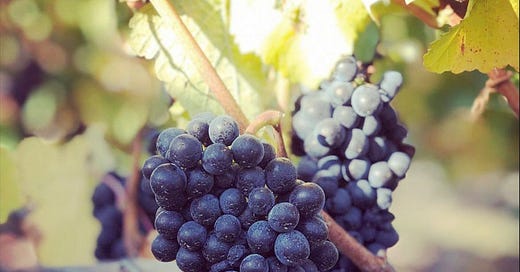A grape question: Why is Cabernet Sauvignon usually blended with other Bordeaux grapes, while Pinot Noir, Burgundy’s pride, always stands alone?
We could dismiss this as just another of the many arbitrary rules that go back to the classic explanation, “we’ve always done it that way,” that often prevails in wine (and other arenas, too).
Cabernet Sauvignon is usually blended with other grapes. Pinot Noir almost never is.
Do you have a preference between these two approaches?
But these rules, going back centuries and enforced as formal regulations in France, didn’t just happen by accident. They reflect fundamental differences in the nature of these two iconic red grapes.
Pinot Noir, all on its own, has been historically prized for delicacy and nuance. It also has a reputation as a finicky grape in the vineyard and the winery. It is known for expressing its terroir, to the extent that a distance of a few yards on a Burgundian hillside can reveal a different character in the finished wine.
At its best, Pinot’s subtle red fruit, herbal, and earthy aromas and flavors come together in ethereal harmony. Blending in other grapes could risk drowning out Pinot’s recognizable voice. All this explains why – with the singular exception of its role in Blanc de Noir Champagne — Pinot Noir almost always stands on its own.
“Clouston & Co’s estate grown Pinot Noir is almost ready to be harvested! An outstanding growing season in Marlborough, New Zealand has resulted in exceptional fruit to create our 2020 Pinot Noir.”
–Instagram post by Clouston & Co., March 18, 2020.
In contrast, youthful Cabernet Sauvignon is typically darker, bolder, and more structured. It shows concentrated flavors like black currant and cedar, and shrouds them in a vault of tannic astringency that requires cellaring before it’s best enjoyed. (Yes, quality Burgundy needs aging, too, but high-end Bordeaux takes tannin to another level.)
Cabernet Sauvignon’s power makes it a good team player, so in Bordeaux it is usually blended in varying proportions with Merlot, Cabernet Franc, and less commonly Petit Verdot or Malbec. If we think about wine as music, Cabernet Sauvignon plays a lead role in a symphony; Pinot Noir stars in a solo performance.
Similar principles apply as these classic grapes have migrated around the world: Although single-varietal Cabernets have become more commonplace in the New World, from the U.S. West Coast to Australia, the Bordeaux blend still reigns supreme. As for Pinot Noir, its solo status survives international travel. Pinot blends, other than the occasional sparkling wine, are rare.
All this talk made me crave a Pinot Noir, and happily I found a good one for this week’s featured wine. Clouston & Co 2020 Marlborough Pinot Noir hails from New Zealand, about as far from Burgundy in France as it’s possible to get. But its subtle complexity and characteristic varietal flavors demonstrate that Pinot Noir, well handled in the soil and in the winemaker’s hands, can maintain its character in any hemisphere.
Since I buy all the wines I review at retail and do not accept wine samples or other gratuities from the industry, I count on the support of paid subscribers to help cover the cost of the wines I review. So, I have to reserve wines over about $20 behind a subscription paywall. If you haven’t become a full subscriber yet, I’d love to have your support. Click here for information on our paid-tier edition. Our free-to-all edition featuring a quality wine for $20 or less will return in its biweekly cycle next week.
Support The 30 Second Wine Advisor with your paid-tier subscription. For $5 per month or $50 for a year (a 17% saving), you’ll receive additional wine notes funded by your subscriptions, gain quick direct access through Substack for wine-related questions, and gain my real appreciation for your support.
Keep reading with a 7-day free trial
Subscribe to The 30 Second Wine Advisor to keep reading this post and get 7 days of free access to the full post archives.






